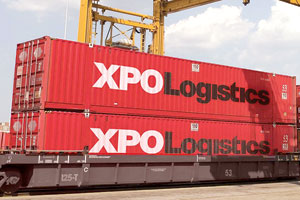XPO Quarterly Results Soar, Bolstered by LTL, Last Mile

This story appears in the May 8 print edition of Transport Topics.
XPO Logistics Inc. earned a profit in the first quarter of the year for the first time since 2010, rocketing past analyst expectations on the strength of its linehaul, cross-dock and pickup-and-delivery operations.
The less-than-truckload and third- party-logistics provider earned $19.5 million, or 16 cents per share. The forecast from a Bloomberg News survey of industry analysts was $7.4 million, or 7 cents.
That compares with a loss in the year-ago quarter of $23.2 million, or 21 cents.
The quarter’s results continue the Greenwich, Conn.-based company’s turnaround. XPO had not earned profits in 18 consecutive quarters prior to the middle of 2016.
“We had another fantastic quarter,” CEO Brad Jacobs told Transport Topics. “We’re on a roll with sales, signing the largest contract of any of our business lines in our history. It’s an intermodal contract.”
He said the company also won a large contract to manage reverse logistics in North America for a global consumer brand. “We closed a record $716 million of new business in the quarter, up 67% versus last year.”
Revenue slightly decreased year-over-year to $3.54 billion from $3.55 billion.
However, Jacobs noted that XPO still owned the old Con-way truckload division in early 2016 — which TFI International purchased last October. Excluding the Con-way truckload business, XPO revenue increased 3.5%, or $122.6 million, compared with last year.
Net revenue, the amount remaining after removing transportation costs, rose 4.5% to $338.8 million in the less-than-truckload business and increased 15% in last-mile to $61.5 million but fell 6.2% in freight brokerage to $85.9 million. The freight brokerage division consists of truck brokerage, intermodal and expedited services.
“Truck brokerage revenue grew 14% and volume grew 10%, but margins were pressured industrywide and we were not immune to that,” Jacobs acknowledged. “I would characterize it as a loose [truckload] market; capacity is ample.” He said contract rates were flat to down versus 2016 levels.
XPO’s intermodal business struggled in the first quarter because the loose market provided shippers a cost-effective trucking alternative to the railroads for longhauls, he explained.
“While intermodal as an area was weak, we’ve gotten some big wins there recently that should improve the profitability of that business going forward,” Jacobs said.
Operating income year-over-year surged 49% to $78.2 million in the North American less-than-truckload business and also jumped 48% to $47.2 million in the logistics unit.
“How many businesses — not just in transportation, but in any business — grow operating income 49% on a year-over-year basis?” Jacobs boasted to TT.
In less-than-truckload, total pounds per day rose 4.8%, shipments per day went up 0.9%, and weight per shipment climbed 3.8%. Revenue per 100 pounds of freight increased 1.2%, but it fell 1.1% when fuel surcharges were removed from the total.
Last-mile business, driven primarily by the e-commerce boom, reported a 16% increase in top-line revenue. Jacobs said strong performers included last-mile deliveries for appliances, furniture and electronics.
XPO ranks No. 1 on the Transport Topics Top 50 list of the largest logistics companies in North America, and No. 3 on the Top 100 list of the largest U.S. and Canadian for-hire carriers.
The company said it still expects to have 2017-18 free cash flow of approximately $900 million, including at least $350 million of free cash flow generated this year.
It also expects an adjusted earnings before interest, taxes, depreciation and amortization of at least $1.35 billion in 2017 and $1.58 billion in 2018.

